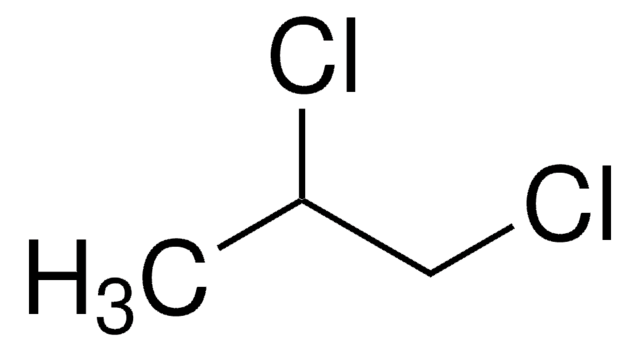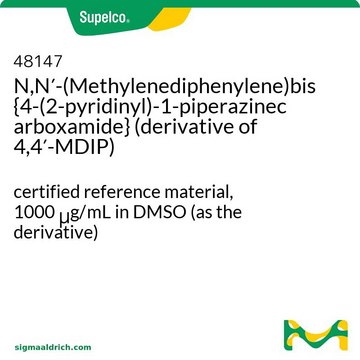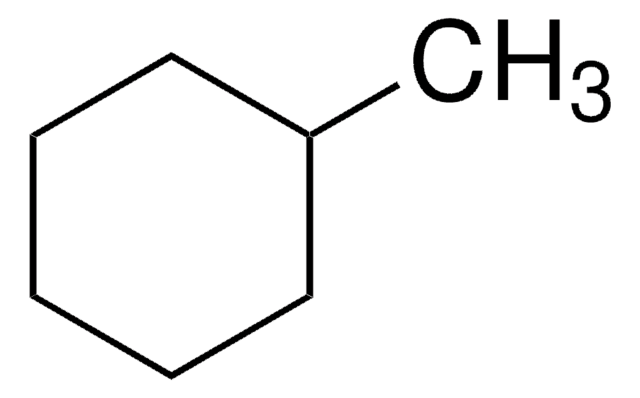D62403
1,2-Dichloroethylene, mixture of cis and trans
98%
Synonym(s):
1,2-Dichloroethene, Acetylene dichloride, sym-Dichloroethylene
Sign Into View Organizational & Contract Pricing
All Photos(1)
About This Item
Linear Formula:
ClCH=CHCl
CAS Number:
Molecular Weight:
96.94
EC Number:
MDL number:
UNSPSC Code:
12352100
PubChem Substance ID:
NACRES:
NA.22
Recommended Products
vapor pressure
5.32 psi ( 20 °C)
Assay
98%
form
liquid
refractive index
n20/D 1.447 (lit.)
bp
48-60 °C (lit.)
mp
−57 °C (lit.)
density
1.265 g/mL at 25 °C (lit.)
SMILES string
Cl\C=C\Cl
InChI
1S/C2H2Cl2/c3-1-2-4/h1-2H/b2-1+
InChI key
KFUSEUYYWQURPO-OWOJBTEDSA-N
Looking for similar products? Visit Product Comparison Guide
General description
1,2-Dichloroethylene, also known as acetylene dichloride, is a chlorinated aliphatic hydrocarbon that is commonly used as an extraction solvent and as a chemical intermediate for other chlorinated solvents and compounds.
Application
1,2-Dichloroethylene, mixture of cis and trans can be used as a reactant to synthesize:
- Chloro-enynes from terminal alkynes via Sonogashira coupling.
- Trichloroethyl alkyl ketones by reacting with acyl chlorides via Friedel-Crafts reaction in the presence of aluminum chloride.
- (Ethenediyl)bis[thiazole] via Pd-catalyzed Stille-coupling reaction with 2-(tributylstannyl)thiazole.
accessory
Product No.
Description
Pricing
Signal Word
Danger
Hazard Statements
Precautionary Statements
Hazard Classifications
Acute Tox. 4 Inhalation - Aquatic Chronic 3 - Flam. Liq. 2
Storage Class Code
3 - Flammable liquids
WGK
WGK 2
Flash Point(F)
42.8 °F - closed cup
Flash Point(C)
6 °C - closed cup
Personal Protective Equipment
dust mask type N95 (US), Eyeshields, Gloves
Choose from one of the most recent versions:
Already Own This Product?
Find documentation for the products that you have recently purchased in the Document Library.
Customers Also Viewed
Jisu Hong et al.
Chemistry (Weinheim an der Bergstrasse, Germany), 25(2), 649-656 (2018-11-06)
The effects of the molecular structure of thiazole-based polymers on the active layer morphologies and performances of electronic and photovoltaic devices were studied. Thus, thiazole-based conjugated polymers with a novel thiazole-vinylene-thiazole (TzVTz) structure were designed and synthesized. The TzVTz structure
C Andrew Ramsburg et al.
Environmental science & technology, 44(23), 9105-9111 (2010-11-09)
Abiotic and biotic reductive dechlorination with chlorinated ethene dense non-aqueous-phase liquid (DNAPL) source zones can lead to significant fluxes of complete and incomplete transformation products. Accurate assessment of in situ rates of transformation and the potential for product sequestration requires
Florian Schevenels et al.
Chemistry (Weinheim an der Bergstrasse, Germany), 19(13), 4335-4343 (2013-01-22)
Highly functionalised benzofurans have been prepared from ortho-hydroxyphenones and 1,1-dichloroethylene. The key intermediate, a chloromethylene furan, smoothly rearranged into the corresponding benzofuran carbaldehyde under acidic conditions. Some mechanistic investigations have been performed and several biologically active benzofurans have been synthesised.
He-Ping Zhao et al.
Water research, 44(7), 2276-2282 (2010-01-19)
The presence of other chloroethenes influences aerobic metabolic biodegradation of cis-1,2-dichloroethene (cDCE). A new metabolically cDCE degrading enrichment culture was identified as also being capable of degrading vinyl chloride (VC), but not 1,1-dichloroethene (1,1DCE), trans-1,2-dichloroethene (tDCE), trichloroethene (TCE), or tetrachloroethene
He-Ping Zhao et al.
Water science and technology : a journal of the International Association on Water Pollution Research, 64(9), 1796-1803 (2011-10-25)
Degradation of the lower chlorinated ethenes is crucial to the application of natural attenuation or in situ bioremediation on chlorinated ethene contaminated sites. Recently, within mixtures of several chloroethenes as they can occur in contaminated groundwater inhibiting effects on aerobic
Our team of scientists has experience in all areas of research including Life Science, Material Science, Chemical Synthesis, Chromatography, Analytical and many others.
Contact Technical Service











